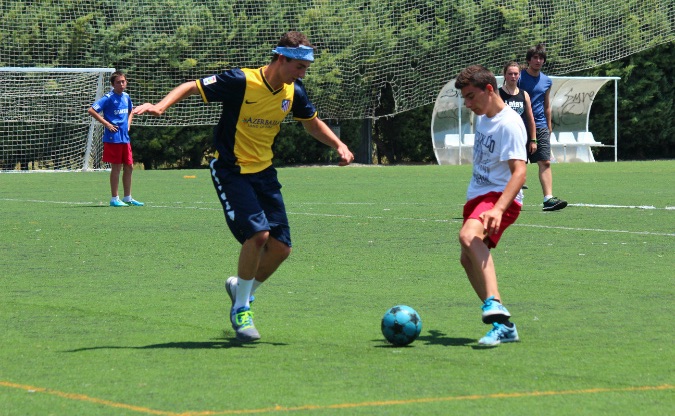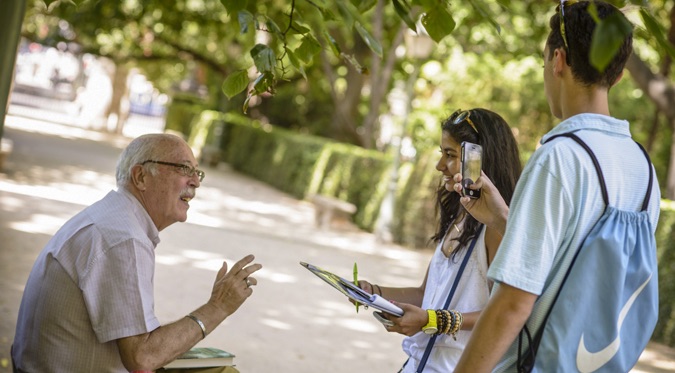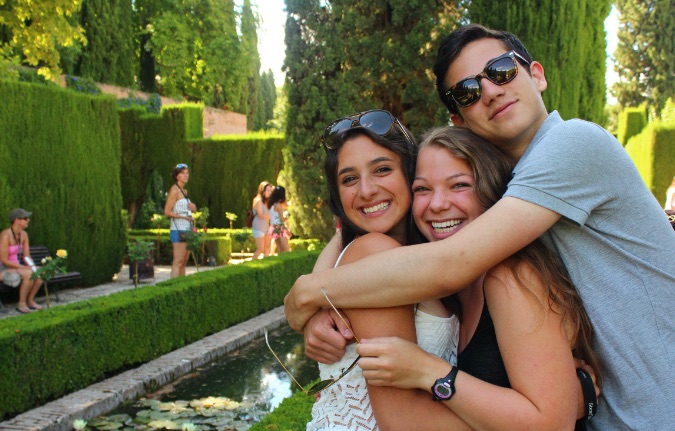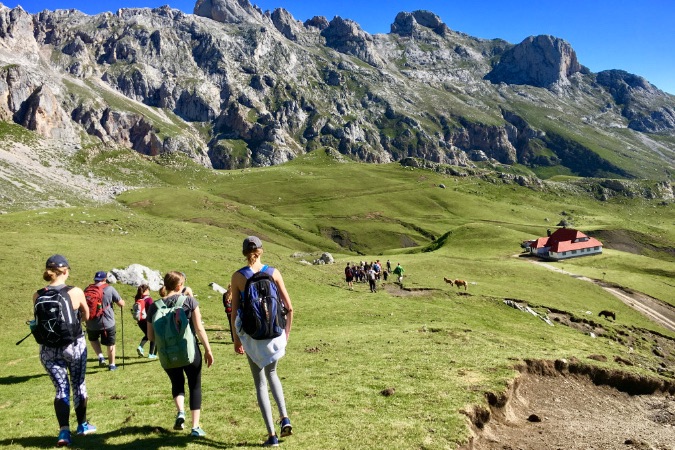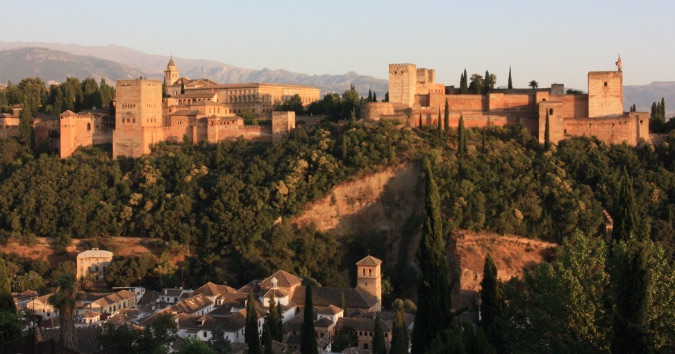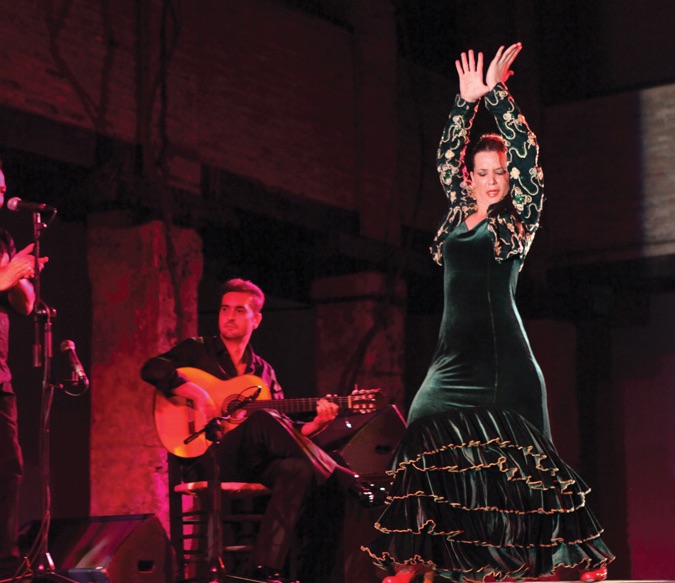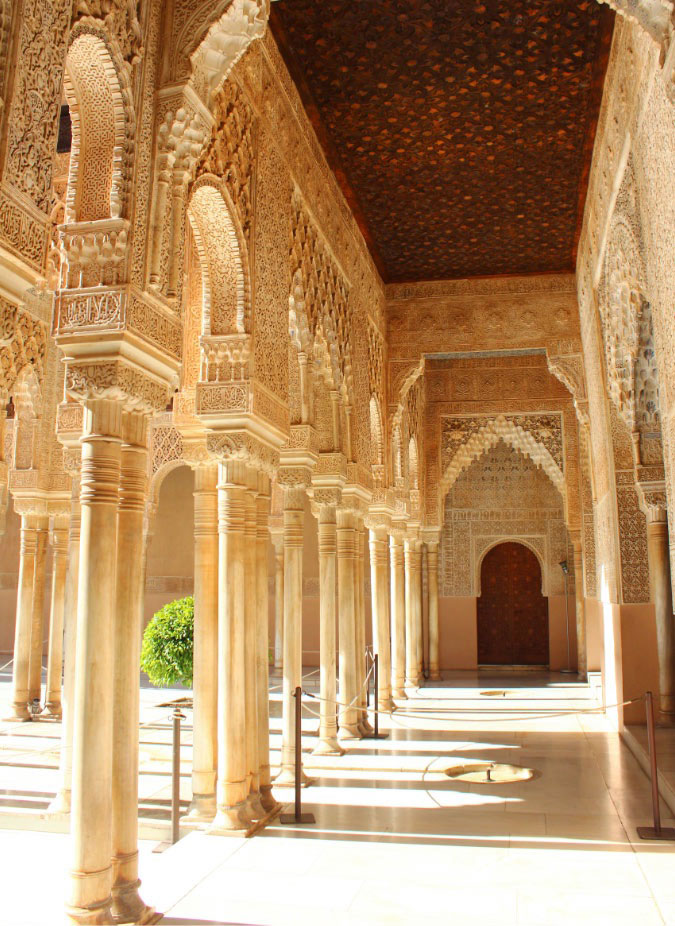Spain
From Mountain Passes to the Costa del Sol
Immerse yourself in the Spanish language and culture as you visit renowned art museums, explore ancient castles, learn to surf on Spain’s northern coast, hike through the Picos de Europa and take in the impressive rock formations, and pair up with a local teenager for a language exchange and day stay. End your student travel program in Spain on the gorgeous beaches of the Costa del Sol after outdoor adventures in the Alpujarras region.
- Highlights
• Spend time with a host sibling and join their family for several days
• Learn to dance flamenco with a professional instructor
• Hike past shepherds and their herds in the Picos de Europa
Itinerary
This itinerary represents our best projection of the group’s schedule. However, we may implement changes designed to improve the quality of the program.
Meet your fellow high school student travelers and one or more of your leaders in New York, and fly together to Madrid, Spain. To learn more about how we organize travel, click here.
Begin the program with four days in a small Asturian fishing village on Spain’s gorgeous northern coast. Immerse yourself in the Spanish language and culture, and get to know your fellow travelers as you participate in daily language lessons. Visit local fiestas and markets, and play soccer on the beach with new Spanish friends. Enjoy a surfing lesson in the blue waters of the Cantabrian Sea. Visit Covadonga, a major Asturian pilgrimage site. It was here that the Virgin Mary appeared to Don Pelayo in a cave and inspired his troops to defeat Moorish soldiers at the Battle of Covadonga in 722. Learn about Christian troops’ first victory during the Muslim occupation of Spain and the 700-year Reconquista that followed.
Travel south to the snowcapped Picos de Europa. Ride a teleférico, or gondola, into the mountains. Hike on spectacular trails past cows, sheep, horses, and goats. Meet local farmers who spend the summer months in the mountains with their herds, and taste Asturian cheeses. Go canyoning in a mountain river, rappelling down waterfalls and jumping into natural pools.
Explore Madrid’s lively streets, sample local delicacies at a tapas market, and take in an outdoor film or a flamenco show. Visit world-renowned museums including the Prado and Reina Sofía, and learn about the life and works of Spain’s most celebrated painters, such as Velázquez, Goya, Picasso, and Dalí. Interview local madrileños in the city’s famous Retiro Park, and enjoy a picnic or a rowboat ride. Walk through the dressing rooms, tunnel, and coaching area of Real Madrid’s stadium, Santiago Bernabéu. View tapestries, thrones, and armor at the Royal Palace and learn about the history of the Spanish monarchy. Take a day trip to Toledo to visit the Alcázar and ancient synagogue.
Experience Spanish life as it is really lived alongside your Spanish host sibling. Participate in activities together with Spanish teenagers during the day and get to know them over shared meals. Daily activities may include kayaking, a rousing game of soccer, a concert or film, a visit to a local museum, and an afternoon at the town pool. Spend two full days with your host family and practice Spanish as you join in their daily activities, meet the family, and form lasting friendships. Each night, reconvene with your Putney group and stay together at a local hotel.
Head south to the Andalusian city of Granada. In 1492, Granada was the last Moorish city to surrender to Los Reyes Católicos, thereby ending the Christian reconquest of Spain. Observe many Moorish influences here, from Arabic teahouses to Islamic architecture. Visit the Alhambra Palace and view its stunning gardens, mosaics, and fountains. Soak in a traditional Arabic bath while sipping mint tea, take a flamenco lesson in a traditional cueva, and learn about olive oil production at a nearby olive grove. During language lessons, learn about Spanish words that come from Arabic and study the work of the famous Andalusian poet, Federico García Lorca.
Travel to a whitewashed village in the mountainous Alpujarras region for several days of outdoor adventure. Hike to the summit of Mulhacén, the highest peak on the Iberian Peninsula, and enjoy the crisp mountain air and stunning natural beauty. Take a day trip to Trevélez, where the region’s dry mountain air is used to cure serrano ham in jamón factories, or Lanjarón, famous for its natural springs and bottled water company.
Continue south to a small town on the Costa del Sol, Spain’s Mediterranean coast. Kayak to a deserted beach and spend the morning snorkeling. Invite local children to join you in a game of frisbee or volleyball, and enjoy a sunny picnic. Take a day trip to the charming town of Frigiliana, and walk past whitewashed homes decorated with painted ceramic pots and bright red geraniums. Descend into Nerja’s three mile cave network Las Cuevas de Nerja, and observe enormous stalactites and stalagmites. On your final evening, recount your adventures with new friends, and enjoy a special celebratory meal as a group.
Fly from Málaga to New York with your group and a leader, then continue on to your final destination. Note: The group returning on August 6 flies from Bilbao to New York. To learn more about how we organize travel, click here.
Itinerary
This itinerary represents our best projection of the group’s schedule. However, we may implement changes designed to improve the quality of the program.
Meet your fellow high school student travelers and one or more of your leaders in New York, and fly together to Madrid, Spain. To learn more about how we organize travel, click here.
Begin the program with four days in a small Asturian fishing village on Spain’s gorgeous northern coast. Immerse yourself in the Spanish language and culture, and get to know your fellow travelers as you participate in daily language lessons. Visit local fiestas and markets, and play soccer on the beach with new Spanish friends. Enjoy a surfing lesson in the blue waters of the Cantabrian Sea. Visit Covadonga, a major Asturian pilgrimage site. It was here that the Virgin Mary appeared to Don Pelayo in a cave and inspired his troops to defeat Moorish soldiers at the Battle of Covadonga in 722. Learn about Christian troops’ first victory during the Muslim occupation of Spain and the 700-year Reconquista that followed.
Travel south to the snowcapped Picos de Europa. Ride a teleférico, or gondola, into the mountains. Hike on spectacular trails past cows, sheep, horses, and goats. Meet local farmers who spend the summer months in the mountains with their herds, and taste Asturian cheeses. Go canyoning in a mountain river, rappelling down waterfalls and jumping into natural pools.
Explore Madrid’s lively streets, sample local delicacies at a tapas market, and take in an outdoor film or a flamenco show. Visit world-renowned museums including the Prado and Reina Sofía, and learn about the life and works of Spain’s most celebrated painters, such as Velázquez, Goya, Picasso, and Dalí. Interview local madrileños in the city’s famous Retiro Park, and enjoy a picnic or a rowboat ride. Walk through the dressing rooms, tunnel, and coaching area of Real Madrid’s stadium, Santiago Bernabéu. View tapestries, thrones, and armor at the Royal Palace and learn about the history of the Spanish monarchy. Take a day trip to Toledo to visit the Alcázar and ancient synagogue.
Experience Spanish life as it is really lived alongside your Spanish host sibling. Participate in activities together with Spanish teenagers during the day and get to know them over shared meals. Daily activities may include kayaking, a rousing game of soccer, a concert or film, a visit to a local museum, and an afternoon at the town pool. Spend two full days with your host family and practice Spanish as you join in their daily activities, meet the family, and form lasting friendships. Each night, reconvene with your Putney group and stay together at a local hotel.
Head south to the Andalusian city of Granada. In 1492, Granada was the last Moorish city to surrender to Los Reyes Católicos, thereby ending the Christian reconquest of Spain. Observe many Moorish influences here, from Arabic teahouses to Islamic architecture. Visit the Alhambra Palace and view its stunning gardens, mosaics, and fountains. Soak in a traditional Arabic bath while sipping mint tea, take a flamenco lesson in a traditional cueva, and learn about olive oil production at a nearby olive grove. During language lessons, learn about Spanish words that come from Arabic and study the work of the famous Andalusian poet, Federico García Lorca.
Travel to a whitewashed village in the mountainous Alpujarras region for several days of outdoor adventure. Hike to the summit of Mulhacén, the highest peak on the Iberian Peninsula, and enjoy the crisp mountain air and stunning natural beauty. Take a day trip to Trevélez, where the region’s dry mountain air is used to cure serrano ham in jamón factories, or Lanjarón, famous for its natural springs and bottled water company.
Continue south to a small town on the Costa del Sol, Spain’s Mediterranean coast. Kayak to a deserted beach and spend the morning snorkeling. Invite local children to join you in a game of frisbee or volleyball, and enjoy a sunny picnic. Take a day trip to the charming town of Frigiliana, and walk past whitewashed homes decorated with painted ceramic pots and bright red geraniums. Descend into Nerja’s three mile cave network Las Cuevas de Nerja, and observe enormous stalactites and stalagmites. On your final evening, recount your adventures with new friends, and enjoy a special celebratory meal as a group.
Fly from Málaga to New York with your group and a leader, then continue on to your final destination. Note: The group returning on August 6 flies from Bilbao to New York. To learn more about how we organize travel, click here.
Leaders
Meet some of our featured leaders. Please note that these may not be your leaders for the program.
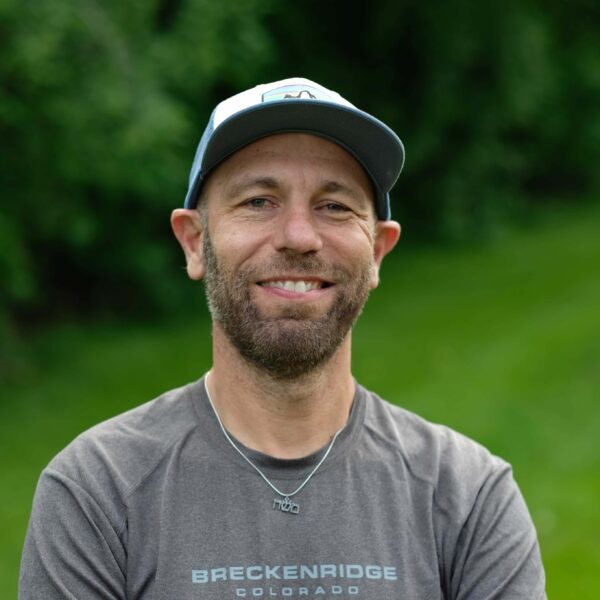
Leaders
Meet some of our featured leaders. Please note that these may not be your leaders for the program.

Spain’s diverse natural beauty, rich history, and worldly culture make it an amazing place to travel. Experience the country’s many contrasts, from the green rocky cliffs that overlook the Cantabrian Sea to the sandy beaches of the Mediterranean, from the bustling El Rastro market in Madrid to the quiet whitewashed streets of Andalucía. Compare Roman aqueducts and Moorish palaces, Renaissance paintings and Cubist masterpieces, and bullfighting rings and Real Madrid’s stadium.
Castellano, or Castilian Spanish, is the official language of Spain, although other languages are spoken in different regions, including Catalan in Cataluña, Galician in Galicia, and Euskara in the Basque Country.
Daytime temperatures during Spain’s summer months range from 80–95ºF/27–35ºC, although it is cooler on the northern coast and in the mountains, where temperatures hover around 70ºF/21ºC in the afternoon, and can be even cooler at night.
Each region of Spain is famous for its own regional specialty, a product of each region’s climate, history, and customs. While northern Spanish cuisine is a hearty reflection of the farming industry and proximity to the Atlantic coast, with specialties like queso manchego and tortilla de patata, southern Spanish cuisine showcases Mediterranean influences with dishes like paella.
Spain’s diverse natural beauty, rich history, and worldly culture make it an amazing place to travel. Experience the country’s many contrasts, from the green rocky cliffs that overlook the Cantabrian Sea to the sandy beaches of the Mediterranean, from the bustling El Rastro market in Madrid to the quiet whitewashed streets of Andalucía. Compare Roman aqueducts and Moorish palaces, Renaissance paintings and Cubist masterpieces, and bullfighting rings and Real Madrid’s stadium.
Castellano, or Castilian Spanish, is the official language of Spain, although other languages are spoken in different regions, including Catalan in Cataluña, Galician in Galicia, and Euskara in the Basque Country.
Daytime temperatures during Spain’s summer months range from 80–95ºF/27–35ºC, although it is cooler on the northern coast and in the mountains, where temperatures hover around 70ºF/21ºC in the afternoon, and can be even cooler at night.
Each region of Spain is famous for its own regional specialty, a product of each region’s climate, history, and customs. While northern Spanish cuisine is a hearty reflection of the farming industry and proximity to the Atlantic coast, with specialties like queso manchego and tortilla de patata, southern Spanish cuisine showcases Mediterranean influences with dishes like paella.
What to Expect
Review specific program expectations here. For more general information:
The goals of this language program abroad are to improve your Spanish proficiency and build your confidence in your conversational skills. Learn new vocabulary and expressions through cultural activities, outdoor adventures, and interactions with locals. Each day, leaders hold dynamic conversational language lessons designed to help you let go of your inhibitions and communicate more easily. Language lessons are fun, interactive, and incorporate hands-on elements such as scavenger hunts, vocabulary games, and informal interviews with local people.
Two years of language study are required for this program. Students on this travel program are required to speak Spanish during the program and must sign a pledge to do so, not only with the many local people you meet, but also with the leaders and within the group. To learn more about our Language programs click here.
Pursue an independent project and explore an aspect of local culture of particular interest to you—build a phrasebook of colloquial expressions, create a cookbook of family recipes that you learn from your day stay family, or learn the lyrics of the summer’s most popular Spanish songs.
To encourage full engagement and immersion in the Putney travel experience, we limit the use of cell phones and other devices on our High School programs. Students are allowed to use their phones in transit to the program, and keep their devices throughout. During in-country orientation, leaders will lock phones with a code, unlocking them for the second half of the program. During the tech-free portion of the program, students have the opportunity for a weekly call home according to a pre-arranged schedule. For more details, please see our FAQ.
This is a physically active summer program. You can expect to hike, swim, and surf. You will also do a lot of walking in Spanish towns and cities. You do not need to be at peak fitness to participate, but it is important that you have a desire to be physically active, and that you are excited about trying all activities.
This program spends some limited time above an elevation of 10,000 feet (3,048 meters). Mulhacén, the highest peak on the Iberian Peninsula, sits at 11,414 feet (3,479 meters).
Accommodations in Spain are varied, ranging from mountain chalets to cosmopolitan hotels. Many of our residences are run by welcoming Spanish families that Putney has known for years. Rooms are a mix of doubles, triples, and quads. Leaders reside together with the students throughout the program.
We begin each day with a traditional Spanish breakfast at our residence. For lunches and dinners, we find small restaurants or go to local markets to purchase food for a picnic. Lunches tend to be the biggest meal of the day in Spain, followed by a siesta. Restaurants range from traditional regional cuisine to a more international selection in larger cities like Madrid and Granada.
What to Expect
Review specific program expectations here. For more general information:
The goals of this language program abroad are to improve your Spanish proficiency and build your confidence in your conversational skills. Learn new vocabulary and expressions through cultural activities, outdoor adventures, and interactions with locals. Each day, leaders hold dynamic conversational language lessons designed to help you let go of your inhibitions and communicate more easily. Language lessons are fun, interactive, and incorporate hands-on elements such as scavenger hunts, vocabulary games, and informal interviews with local people.
Two years of language study are required for this program. Students on this travel program are required to speak Spanish during the program and must sign a pledge to do so, not only with the many local people you meet, but also with the leaders and within the group. To learn more about our Language programs click here.
Pursue an independent project and explore an aspect of local culture of particular interest to you—build a phrasebook of colloquial expressions, create a cookbook of family recipes that you learn from your day stay family, or learn the lyrics of the summer’s most popular Spanish songs.
To encourage full engagement and immersion in the Putney travel experience, we limit the use of cell phones and other devices on our High School programs. Students are allowed to use their phones in transit to the program, and keep their devices throughout. During in-country orientation, leaders will lock phones with a code, unlocking them for the second half of the program. During the tech-free portion of the program, students have the opportunity for a weekly call home according to a pre-arranged schedule. For more details, please see our FAQ.
This is a physically active summer program. You can expect to hike, swim, and surf. You will also do a lot of walking in Spanish towns and cities. You do not need to be at peak fitness to participate, but it is important that you have a desire to be physically active, and that you are excited about trying all activities.
This program spends some limited time above an elevation of 10,000 feet (3,048 meters). Mulhacén, the highest peak on the Iberian Peninsula, sits at 11,414 feet (3,479 meters).
Accommodations in Spain are varied, ranging from mountain chalets to cosmopolitan hotels. Many of our residences are run by welcoming Spanish families that Putney has known for years. Rooms are a mix of doubles, triples, and quads. Leaders reside together with the students throughout the program.
We begin each day with a traditional Spanish breakfast at our residence. For lunches and dinners, we find small restaurants or go to local markets to purchase food for a picnic. Lunches tend to be the biggest meal of the day in Spain, followed by a siesta. Restaurants range from traditional regional cuisine to a more international selection in larger cities like Madrid and Granada.
A Day in the Life: Madrid
- Morning
- Afternoon
- Evening
A Day in the Life:
Madrid
- Morning
- Afternoon
- Evening
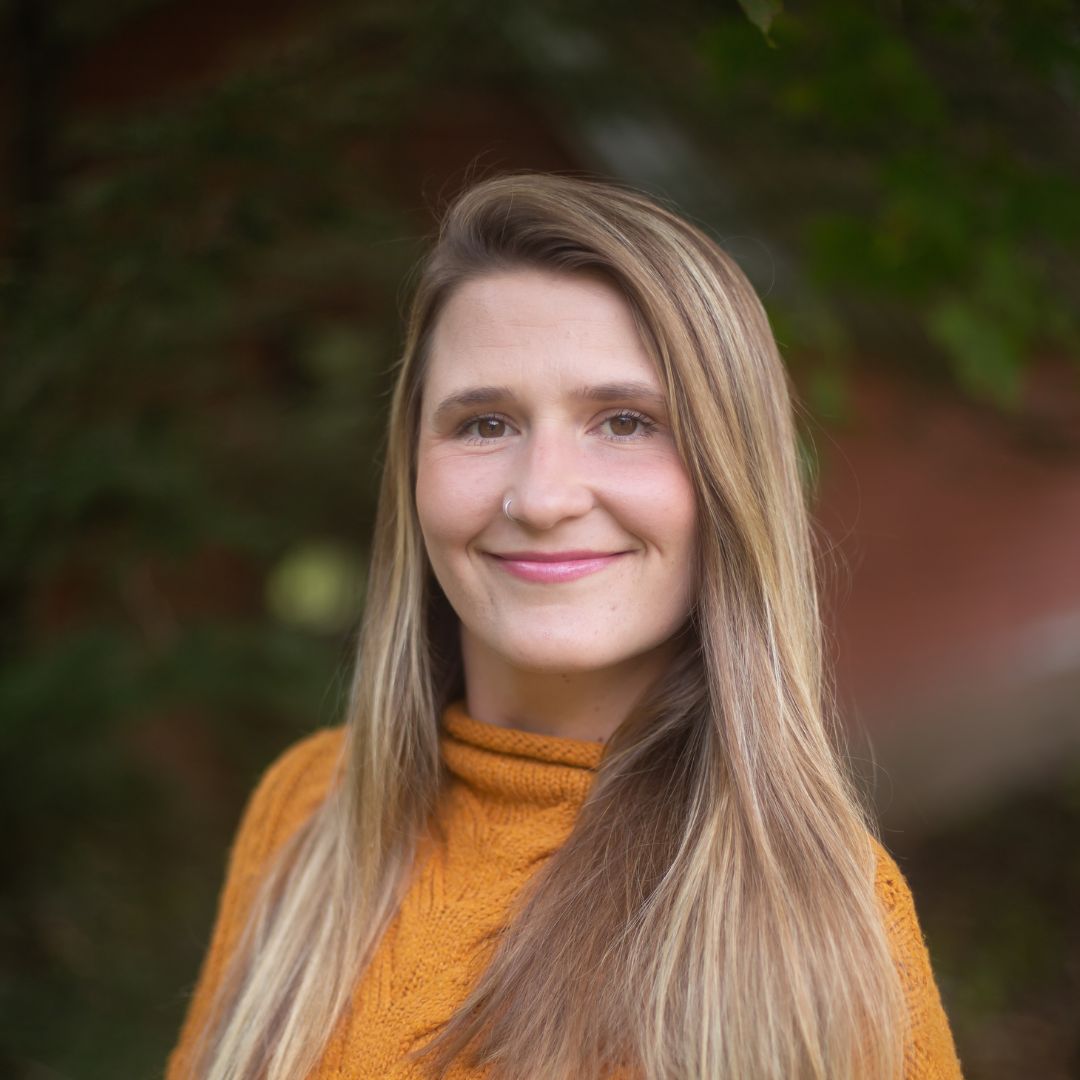
Program Directed by
If you have questions or would like to talk further about this program, please get in touch!




